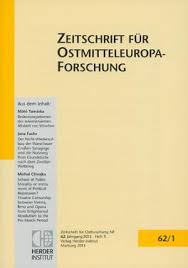Die Kritik der ungarischen Medien an der Politik des „Bruderstaates“ Rumänien in den letzten zwei Jahren des Ceauşescu-Regimes (1987-1989)
Criticism in the Hungarian media of its “brother nation” Romania in the last two years of the Ceauescu-Regime (1987-1989)
Author(s): Peter WeberSubject(s): Media studies, Political history, Social history, Post-War period (1950 - 1989)
Published by: Verlag Herder-Institut
Keywords: Criticism; Hungarian media; “brother nation”; Romania; Ceauescu-Regime (1987-1989);
Summary/Abstract: The noticeable deterioration in Hungarian-Romanian relations at the end of the 1980s gave rise to an unprecedented situation in the history of the Eastern Bloc resp. the Warsaw Pact countries. From 1987 onwards, the ideological differences and political attitudes of the regimes in Budapest and Bucharest opened a wide gulf between both countries, which developed into hostility between the Socialist Republic of Romania and the People’s Republic of Hungary, formerly regarded as “brother nations”. While Budapest went down the path of reform in line with perestrojka and glasnost, the leadership in Bucharest was becoming increasing entrenched as an anti-minority, neo-Stalinist dictatorship, the Conducator Nicolae Ceaușescu at its head. Hungary’s dismal economic perspectives and the changes in the Soviet Union weakened the party’s strict control over the media and, following the 1986 Press Act, allowed more room for the free expression of opinion. The Hungarian media’s criticism of the Ceaușescu regime may be regarded as part of this general liberalisation over control over the media. The employment of experts in many editorial departments, especially within radio and television, the increasing influence of Samizdat publications, together with media appearances by reformers, brought many previously taboo subjects before the public. All the most important state-media, the radio, television, the official press agency MIT, and even the press office of the Communist Party, were affected by this turn of events. At the same time a dispute with deep historical roots flared up between Hungary and Romania. This was used by the Romanian leadership to build up the notion of an external enemy in order to strengthen the internal stability of the regime. There followed even harsher criticism by the Hungarian media, involving not only critical reports, but of all forms of media (music, film, satire). All attempts on the part of the Romanian dictator to silence his Hungarian critics proved unsuccessful. As some of the Hungarian electronic media could also be received across its international border in Western Romania, their criticism of the Ceaușescu-Regime helped to create a feeling of solidarity between the Hungarian and Romanian populations. The outbreak of the popular uprising in Timișoara, followed by those in Arad and other cities of mixed population on the 16th and 21st of December 1989, can be traced back to the effects of these media.
Journal: Zeitschrift für Ostmitteleuropa-Forschung
- Issue Year: 59/2010
- Issue No: 4
- Page Range: 489-503
- Page Count: 15
- Language: German

